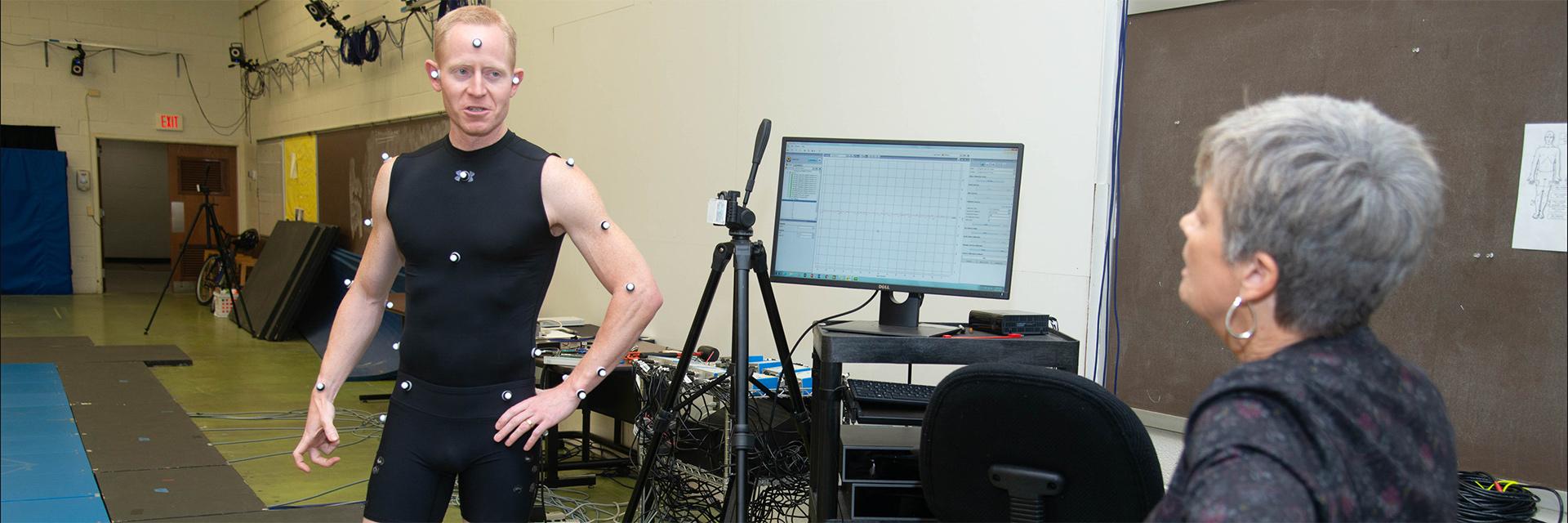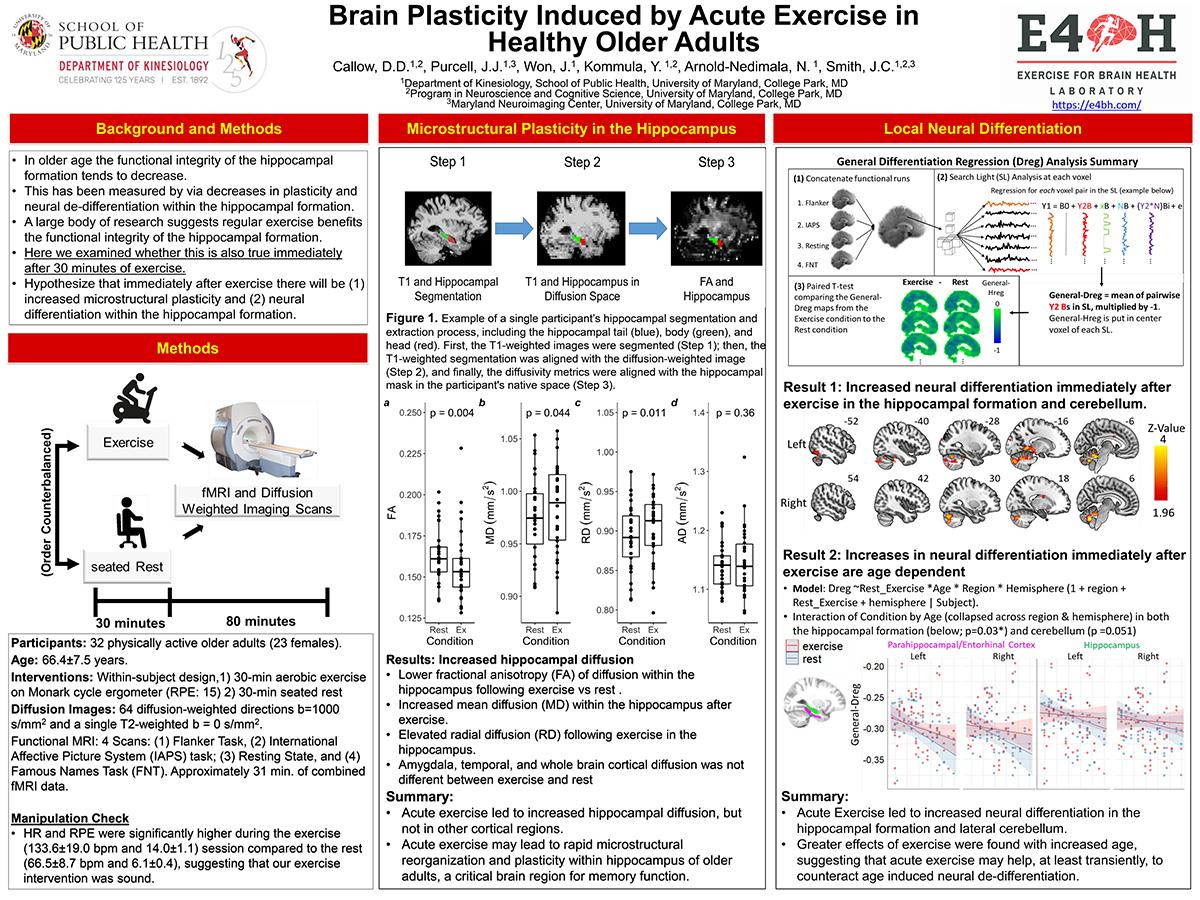
Poster #43
Title: Brain Plasticity Induced by Acute Exercise in Healthy Older Adults
Presenting Author: Daniel Callow, doctoral student UMD SPH Kinesiology)
Authors: Jeremy Purcell, Jun Won, Yash Kommula, Naomi Arnold-Nedimala
Faculty Mentors: J. Carson Smith
Primary Category: Obesity Prevention, Physical Activity, Exercise Physiology, Movement
Secondary Category: Behavioral Health, Mental Health, Substance Abuse
Background: In older age the functional integrity of the hippocampal formation tends to decrease. Meanwhile, a large body of research suggests regular exercise benefits the functional integrity of the hippocampal formation, however, little is known about the underlying mechanisms that contribute to these benefits.
Goals: To determine how a single 30 minute bout of aerobic exercise might modify hippocampal integrity.
Objectives: We hypothesize that immediately after exercise there will be (1) increased microstructural plasticity and (2) neural differentiation within the hippocampal formation compared to after seated rest.
Approach/Methods: Within subject design in which healthy older adults underwent an acute bout of exercise and a seated rest condition (counterbalanced order), immediately followed by neuroimaging measures of the hippocampus.
Results: We found acute exercise let to rapid microstructural reorganization and plasticity within the hippocampus of older adults.
Importance to public health: This provides a better understanding of the immediate effects of aerobic exercise on the hippocampal system, a brain region primarily associated with memory, and that often experiences deterioration with aging and under neurodegenerative diseases like Alzheimer's.
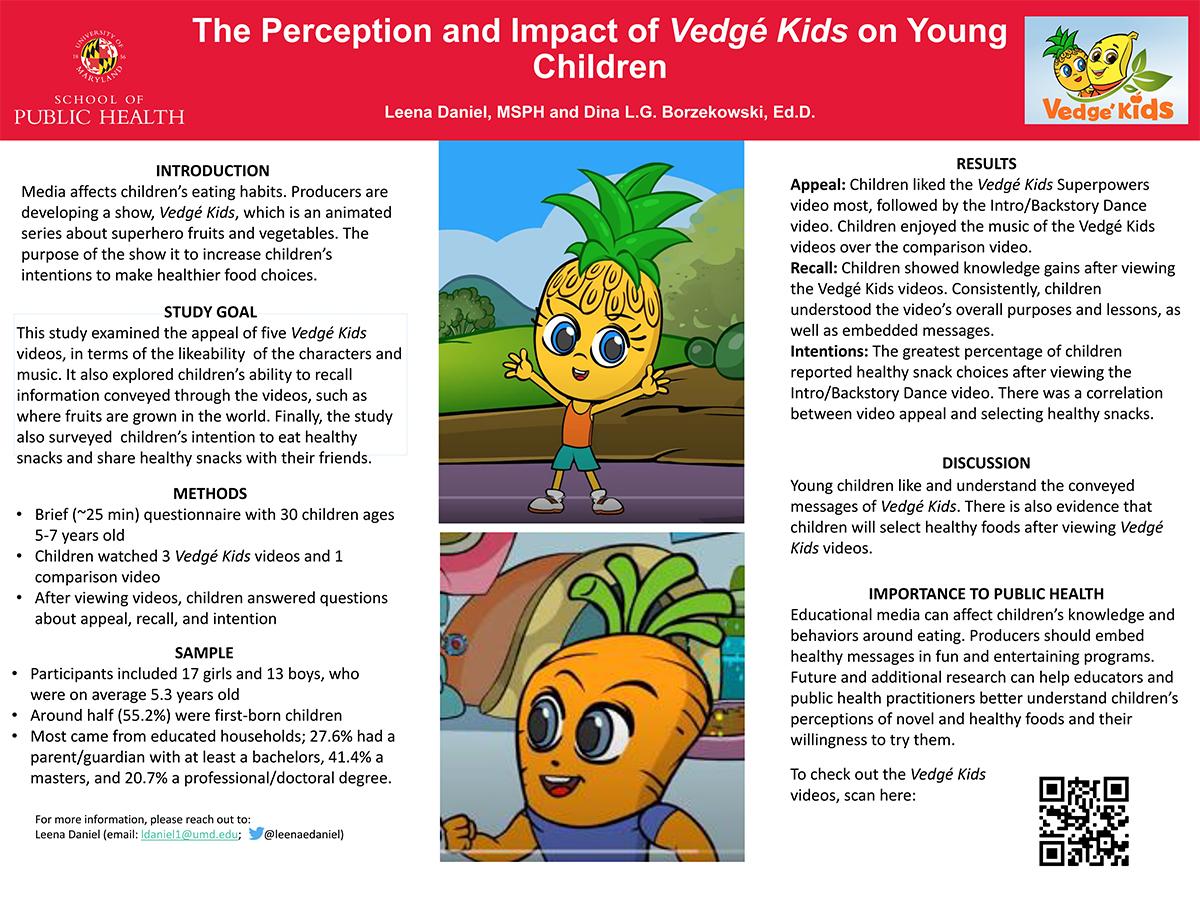
Poster # 44
Title: The Perception and Impact of Vedgé Kids on Young Children
Presenting Author: Leena Daniel, doctoral student UMD SPH Behavioral and Community Health
Faculty Mentors: Dina L.G. Borzekowski
Primary Category: Obesity Prevention, Physical Activity, Exercise Physiology, Movement
Secondary Category: Family, Child, Adolescent Health (Includes Maternal and Child Health)
Background: Media affects children’s eating habits. Producers are developing a show, Vedgé Kids, which is an animated series about superhero fruits and vegetables, in order to increase children’s intentions to make healthier food choices.
Goals: This study examined the appeal of the show, child’s ability to recall information, and the child’s intention to eat healthy snacks.
Objectives:
- This study examined the like-ability of the Vedgé Kids videos, in terms of the character designs, animation style, and background music.
- It also explored children’s ability to recall information conveyed through the videos, such as where fruits are grown in the world and which vitamins come from which fruits.
- The study also surveyed children’s intention to eat healthy snacks and share healthy snacks with their friends.
Approach: Brief (~25 min) questionnaire were developed for children aged 5-7 years old. Children (n=30) watched three out of the five Vedgé Kids videos and one comparison video. After viewing videos, children answered questions about appeal, recall, and intention.
Results: Children liked the Vedgé Kids Superpowers video most, followed by the Intro/Backstory Dance video. Children enjoyed the music of the Vedgé Kids videos over the comparison video. Children showed knowledge gains after viewing the Vedgé Kids videos. Consistently, children understood the video’s overall purposes and lessons, as well as embedded messages. The greatest percentage of children reported healthy snack choices after viewing the Intro/Backstory Dance video. There was a correlation between video appeal and selecting healthy snacks.
Importance to Public Health: Educational media can affect children’s knowledge and behaviors around eating. Future and additional research can help educators and public health practitioners better understand children’s perceptions of novel and healthy foods and their willingness to try them.
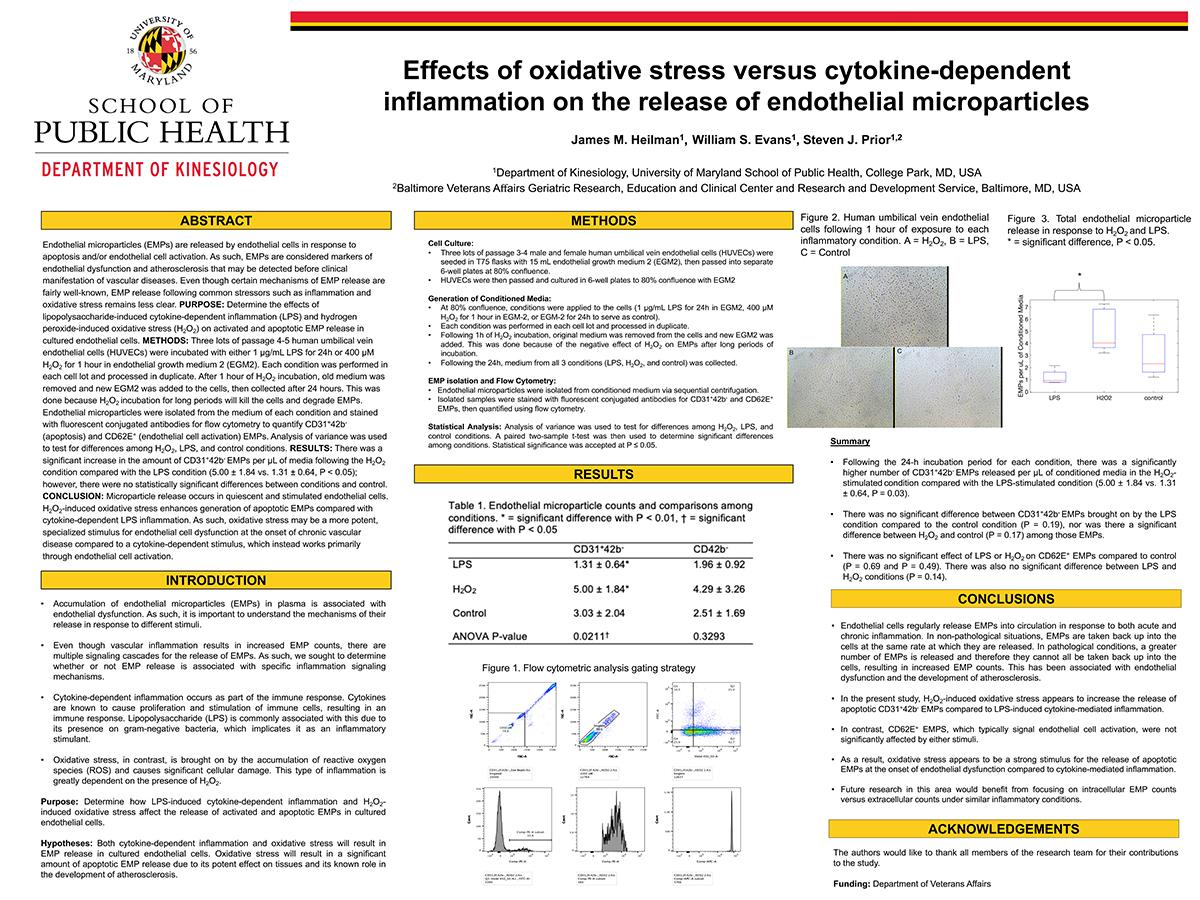
Poster # 45
Title: Effects of oxidative stress versus cytokine-dependent inflammation on the release of endothelial microparticles
Presenting Author: James Heilman, doctoral student UMD SPH Kinesiology
Co-Authors: William Evans, doctoral student UMD SPH Kinesiology
Faculty Mentors: Dr. Steven J. Prior
Primary Category: Obesity Prevention, Physical Activity, Exercise Physiology, Movement
Background: Endothelial microparticles (EMPs) are released by endothelial cells in response to apoptosis and/or endothelial cell activation. As such, EMPs are considered markers of endothelial dysfunction and atherosclerosis that may be detected before clinical manifestation of vascular diseases.
Goals: Determine the effects of lipopolysaccharide-induced cytokine-dependent inflammation (LPS) and hydrogen peroxide-induced oxidative stress (H2O2) on activated and apoptotic EMP release in cultured endothelial cells.
Objectives:
- Both cytokine-dependent inflammation and oxidative stress will result in EMP release in cultured endothelial cells.
- Oxidative stress will result in a significant amount of apoptotic EMP release due to its potent effect on tissues and its known role in the development of atherosclerosis.
Approach: Three lots of passage 4-5 human umbilical vein endothelial cells (HUVECs) were incubated with either 1 µg/mL LPS for 24h or 400 µM H2O2 for 1 hour in endothelial growth medium 2 (EGM2). Each condition was performed in each cell lot and processed in duplicate. After 1 hour of H2O2 incubation, old medium was removed and new EGM2 was added to the cells, then collected after 24 hours. This was done because H2O2 incubation for long periods will kill the cells and degrade EMPs. Endothelial microparticles were isolated from the medium of each condition and stained with fluorescent conjugated antibodies for flow cytometry to quantify CD31+42b- (apoptosis) and CD62E+ (endothelial cell activation) EMPs. Analysis of variance was used to test for differences among H2O2, LPS, and control conditions.
Results: There was a significant increase in the amount of CD31+42b- EMPs per µL of media following the H2O2 condition compared with the LPS condition (5.00 ± 1.84 vs. 1.31 ± 0.64, P < 0.05); however, there were no statistically significant differences between conditions and control.
Importance to public health: Microparticle release occurs in quiescent and stimulated endothelial cells. H2O2-induced oxidative stress enhances generation of apoptotic EMPs compared with cytokine-dependent LPS inflammation. As such, oxidative stress may be a more potent, specialized stimulus for endothelial cell dysfunction at the onset of chronic vascular disease compared to a cytokine-dependent stimulus, which provides important mechanistic insight into atherosclerosis progression that may inform future treatment.

Poster #46
Title: Acute Aerobic Exercise and Emotional Processing in Active Older Adults
Presenting Author: Yash Kommula (UMD SPH kinesiology doctoral student )
Authors: Jeremy J. Purcell; University of Maryland, College Park, Department of Kinesiology; Faculty, Daniel D. Callow; University of Maryland, College Park, Department of Kinesiology; Student, Jun Won; University of Maryland, College Park, Department of Kinesiology; Student, Gabriel Pena; University of Maryland, College Park, Department of Kinesiology; Student, Naomi Arnold-Nedimala; University of Maryland, College Park, Department of Kinesiology; Study Coordinator, J. Carson Smith; University of Maryland, College Park, Department of Kinesiology; Faculty
Faculty Mentors: Dr. J. Carson Smith
Primary Category: Obesity Prevention, Physical Activity, Exercise Physiology, Movement
Secondary Category: Behavioral Health, Mental Health, Substance Abuse
Background: The well-elucidated mood-improving capability of exercise in older adults presumably involves adaptations after each exercise session in brain networks that process emotion. However, little is known about effects of acute exercise on appetitive and aversive emotion-related network recruitment in older adults.
Goals: To determine the effect of acute exercise on pleasant and unpleasant emotion-related regional activation in healthy older adults, compared to a seated rest condition.
Objectives: It was hypothesized that after exercise, brain regions classically implicated in emotion regulation would be less active during pleasant emotion processing, and brain regions typically involved in unpleasant emotion processing would be less active during unpleasant emotion processing. It was also hypothesized that cortical regions known to exert inhibitory influence on subcortical emotion circuits would be more active during unpleasant emotion processing.
Approach/Methods: Functional MRI data were acquired in 31 active older adults during blocked presentations of pleasant, neutral, and unpleasant images from the International Affective Pictures System. fMRI data were collected after participants completed 30-minutes of moderate intensity cycling and after a 30-minute seated rest condition – conditions were performed in a counterbalanced order on separate days in a within-subjects design. Activation to pleasant and unpleasant stimuli were expressed relative to neutral stimuli (FWER p<.05).
Results: L/R-DLPFC together showed significantly greater unpleasant activation after exercise when compared to after rest, when accounting for condition, hemisphere of ROI, scan order, and age. A portion of the right DLPFC ROI showed significantly greater unpleasant activation after exercise when compared to after rest. L-cerebellum crus I/II, R-AG/SMG, L/R-medial SFG, and L-AG/SMG/TPJ/MTG showed significantly greater unpleasant activation after exercise when compared to after rest. L-FG/ITG showed significantly less unpleasant activation after exercise versus after rest. Finally, L/R-precuneus had significantly less pleasant activation after exercise when compared to after rest.
Importance to public health: The world population is aging rapidly, and it is estimated that 22% of all humans in 2050 will be aged 60 years or older. A large proportion of older adults experience some mental health concern, and this can limit their life productivity and quality as well as worsen prognosis of any existing diseases - thus, it is crucial to investigate how acute exercise may influence emotional brain activation as we aim to better understand physical activity intervention's efficacy and mechanisms in improving mood.
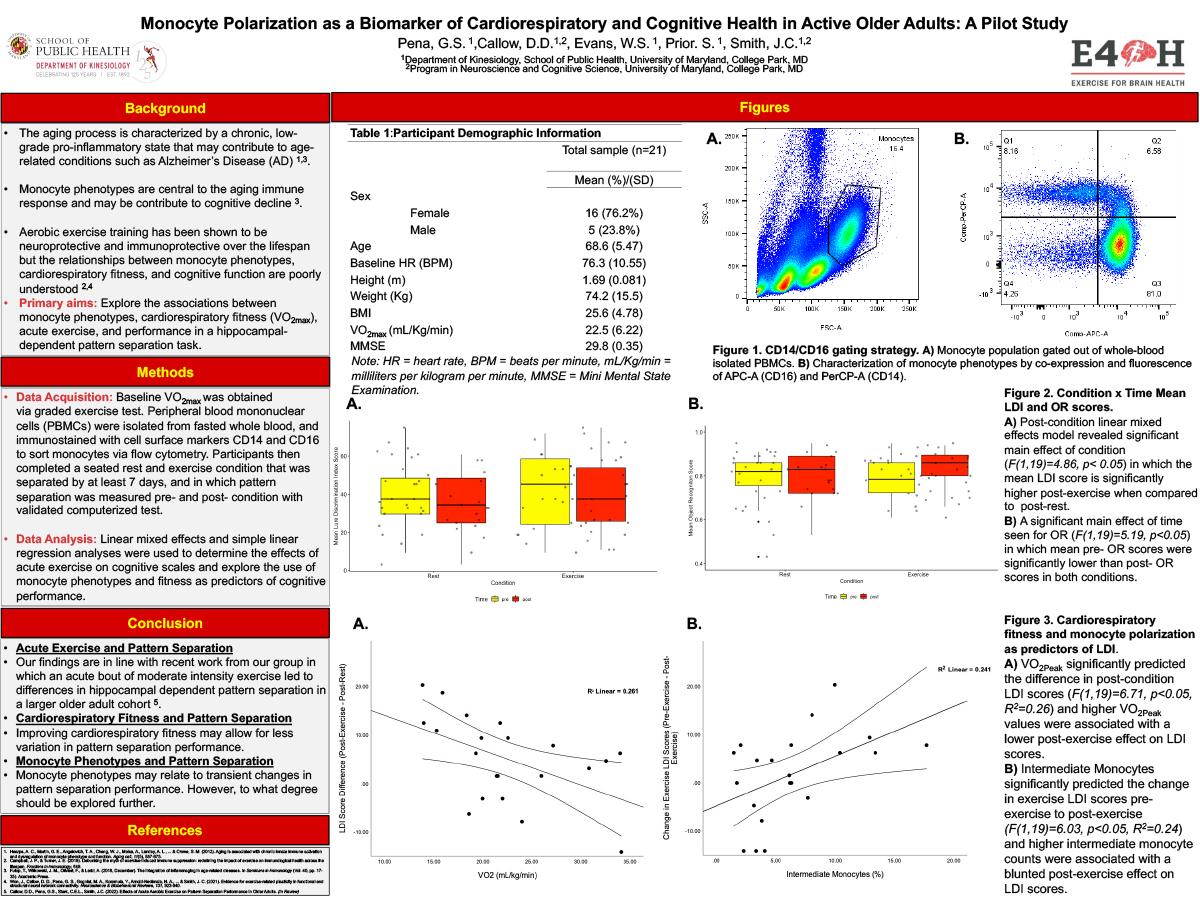
Poster # 47
Title: Monocyte Polarization as a Biomarker of Cardiorespiratory and Cognitive Health in Active Older Adults: A Pilot Study
Presenting Author: Gabriela Pena, doctoral student UMD SPH Kinesiology)
Authors: Daniel D. Callow, UMD, NACS, Student, William S. Evans, UMD, Kinesiology, Student, Steven J. Prior, Ph.D., UMD, Kinesiology, Faculty.
Faculty Mentors: J. Carson Smith, Ph.D.
Primary Category: Obesity Prevention, Physical Activity, Exercise Physiology, Movement
Secondary Category: Innovative Solutions to Public Health Challenges
Background: The aging process is characterized by a chronic, low-grade pro-inflammatory state that may contribute to age-related conditions such as Alzheimer’s Disease (AD). Recent frameworks suggest monocyte phenotypes play key roles in the aging immune response that may exacerbate AD pathology and contribute to cognitive decline. Lifestyle behaviors, such as aerobic exercise training, can be neuroprotective and immunoprotective but the relationships between monocyte phenotypes, cardiorespiratory fitness, and cognitive function are poorly understood.
Goals: To explore the associations between monocyte phenotypes, cardiorespiratory fitness (VO2max), and performance in a hippocampal-dependent pattern separation task.
Objectives:
- Address whether monocyte phenotypes would be predictive of any changes in pattern separation task performance between a rest and exercise condition.
- Explore whether cardiorespiratory fitness is predictive of any changes in pattern separation task performance between a rest and exercise condition.
Approach/Methods: Pearson product-moment correlations were first employed to explore and determine the nature of any relationships between, monocyte polarization, cardiorespiratory fitness, pattern separation. To determine the effects of acute exercise on LDI scores a linear mixed effects model was used, in which Participant ID was a random effect and Condition (rest v. exercise) and Time (pre- v post-) were used as fixed main effects. Further, to control for variance related to order of condition, Order was also used as a fixed effect. Because most of the prior studies that have reported effects of exercise on pattern separation performance have employed a post-intervention analysis only, we also performed a post-intervention analysis where Condition and Order were modeled as fixed effects and Participant ID as a random effect. Lastly, a series of simple linear regression models were used to determine the amount of variance accounted for by baseline monocyte phenotypes and cardiorespiratory fitness for LDI scores post-intervention.
Results: Post-condition linear mixed effects model controlling for order revealed a significant main effect of Condition (F(1,20)=4.86, p<0.05). Specifically, post-rest LDI scores were significantly lower than post-exercise LDI scores (t(20)= -2.65, p<0.02, d= -0.57). Within the exercise condition, intermediate monocytes were found to be significant predictors of the change in pre-exercise to post-exercise LDI scores (F(1, 19)=6.03, p <0.05, R2=0.24) while classical (F(1, 19)=1.75, p >0.05, R2=0.08) and non-classical monocytes (F(1, 19)=1.59, p >0.05, R2=0.07) were not. Further, while cardiorespiratory fitness was not a significant predictor of the changes between pre- to post-rest (F(1, 19)=0.14, p >0.05, R2=0.008) or pre- to post-exercise (F(1, 19)=0.31, p >0.05, R2=0.01) LDI scores, cardiorespiratory fitness was a significant predictor in the difference between post-rest and post-exercise rest LDI scores (F(1, 19)=6.71, p <0.05, R2=0.26) (Figure 3B, Table 2B). Lastly, neither classical (F(1, 19)=0.025, p >0.05, R2=0.001), intermediate (F(1, 19)=0.96, p >0.05, R2=0.04), or non-classical (F(1, 19)=0.03, p >0.05, R2=0.002) monocytes were significant predictors of cardiorespiratory fitness.
Importance to public health: Understanding the biological mechanisms by which exercise can promote healthy aging may inform behavioral and clinical strategies to allay the burden of age-related pathologies such as AD.
